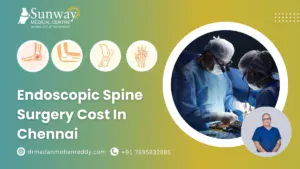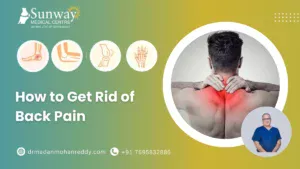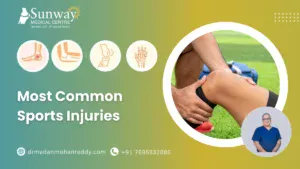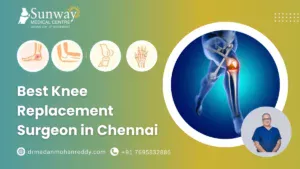Back pain is one of the most common ailments affecting millions of people worldwide. If you are struggling with back pain, you might be wondering, how to get rid of back pain? Whether it’s a mild ache or a sharp, debilitating pain, finding relief is crucial to regaining your quality of life. As Dr. Madan Mohan Reddy often says, “Understanding the root cause is the first step toward effective treatment.” This article will explore the causes, types, symptoms, and treatments for back pain, offering practical tips to help you feel better.
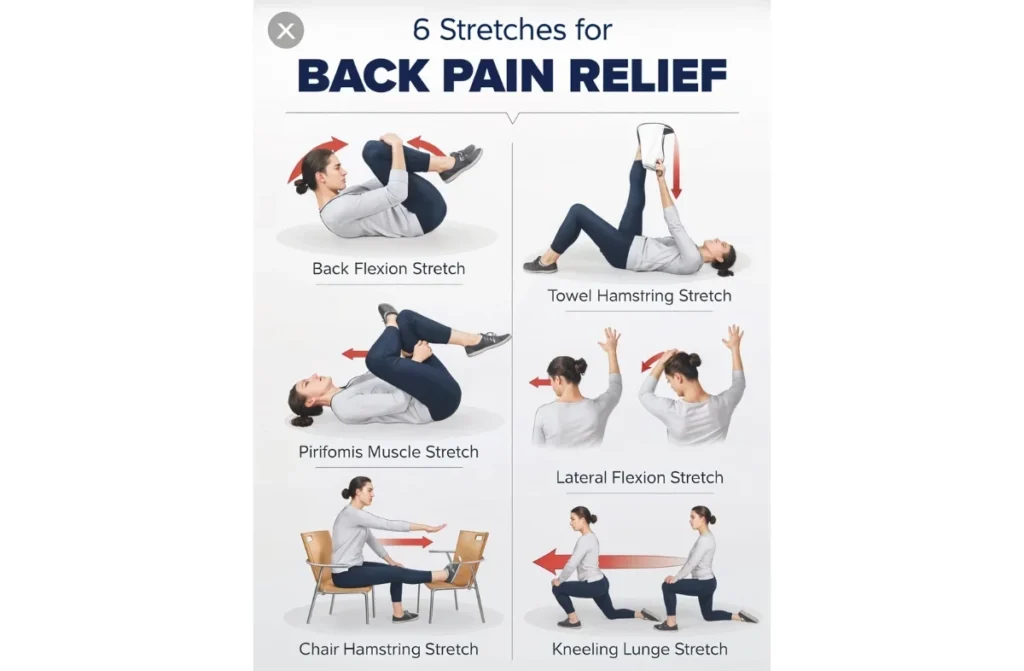
What is Back Pain?
Back pain refers to discomfort or pain in the spinal region, which may range from the neck to the lower back. It can feel sharp, dull, or burning, and it may come and go or persist for weeks. Understanding what is causing my back pain can be a key step toward recovery. Commonly, back pain is categorized based on its duration:
- Acute Back Pain: Lasts for a few days to weeks.
- Chronic Back Pain: Persists for more than three months.
If you’ve been asking yourself how to get rid of back pain, understanding these classifications is the first step.
What Does Back Pain Feel Like?
Back pain can manifest in various ways:
- Localized Pain: A specific area of your back feels sore or tender.
- Radiating Pain: Pain that travels down your legs or arms.
- Muscle Stiffness: Difficulty in moving due to tightness in your back muscles.
- Shooting Pain: Sharp, electric-like sensations, often linked to nerve issues.
These symptoms can help your healthcare provider with back pain diagnosis and treatment, ensuring a more targeted approach.
Types of Back Pain
Back pain can be classified into different types based on its origin:
- Mechanical Back Pain: Caused by strain or injury to the muscles, ligaments, or joints.
- Radicular Back Pain: Caused by irritation or compression of spinal nerves, leading to symptoms like sciatica.
- Inflammatory Back Pain: Linked to conditions like arthritis or ankylosing spondylitis.
If you’ve been searching for what is causing my back pain, identifying the type is crucial for effective treatment.
What Are the Most Common Causes of Back Pain?
If you’re wondering, what is causing my back pain? here are some typical culprits:
- Poor Posture: Sitting or standing improperly for long periods.
- Muscle Strain: Overuse or sudden movements leading to strained muscles.
- Herniated Discs: Discs slipping out of place and pressing on nerves.
- Degenerative Conditions: Age-related wear and tear of the spine.
- Injuries: Falls, accidents, or soft injuries.
How Can I Find Back Pain Relief?
Finding relief often begins with understanding your pain. If you’re asking, how to get rid of back pain, try these general strategies:
- Rest and avoid activities that worsen the pain.
- Apply hot or cold compresses to reduce inflammation and discomfort.
- Practice gentle stretching or yoga to improve flexibility.
- Use over-the-counter pain relievers, such as ibuprofen or acetaminophen, as needed.
10 Ways to Relieve Back Pain
If you’re searching for how to get rid of back pain, try these proven methods:
- Exercise Regularly: Low-impact activities like walking or swimming can strengthen your back muscles.
- Improve Posture: Use ergonomic chairs and maintain a straight spine while sitting.
- Sleep on a Supportive Mattress: A medium-firm mattress provides proper spinal alignment.
- Stay Active: Avoid prolonged bed rest as it can weaken your muscles.
- Stretch Daily: Stretch your hamstrings, lower back, and hips to reduce stiffness.
- Maintain a Healthy Weight: Excess weight can strain your back.
- Use Heat or Cold Therapy: Alternate between ice packs and heating pads for relief.
- Try Physical Therapy: A therapist can teach exercises to strengthen and stabilize your spine.
- Consider Alternative Therapies: Techniques like acupuncture or chiropractic care may help.
- Consult a Specialist: Seek help from a professional for back pain diagnosis and treatment if symptoms persist.
What Are the Symptoms of Lower Back Pain?
Lower back pain often comes with additional symptoms, such as:
- Pain that worsens with movement.
- Muscle spasms or tightness.
- Numbness or tingling in the legs.
- Weakness in the lower extremities.
These symptoms are critical in understanding what is the best treatment for lower back pain?.
What Causes Low Back Pain?
When considering what is causing my back pain, low back pain is often linked to:
- Lifting Heavy Objects: Improper lifting techniques can strain your back.
- Prolonged Sitting: Desk jobs and lack of movement lead to stiffness.
- Sports Injuries: Sudden movements or overuse during sports activities.
How to Prevent Back Pain
Prevention is always better than cure. Here’s how you can avoid back pain:
- Exercise Daily: Strengthen core muscles to support your spine.
- Lift Smartly: Bend your knees and keep your back straight when lifting.
- Use Proper Footwear: Wear supportive shoes to reduce back strain.
- Take Frequent Breaks: If you’re sitting for long periods, stand up and stretch every hour.
These measures can help you stop asking, how to get rid of back pain, by addressing it before it starts.
What Are the Treatments for Lower Back Pain?
If you’re wondering, what is the best treatment for lower back pain? here are some options:
- Medications: Nonsteroidal anti-inflammatory drugs (NSAIDs) or muscle relaxants.
- Physical Therapy: Targeted exercises to reduce pain and improve mobility.
- Injections: Corticosteroid injections to reduce inflammation.
- Surgery: Procedures like discectomy or spinal fusion for severe cases.
- Lifestyle Changes: Maintaining a healthy diet and exercise regimen.
Risk Factors for Back Pain
Certain factors increase the risk of developing back pain:
- Age: Back pain becomes more common with age.
- Obesity: Extra weight strains the spine.
- Sedentary Lifestyle: Lack of physical activity weakens muscles.
- Smoking: Reduces blood flow to the spine, slowing healing.
Back Pain Diagnosis and Treatment
Accurate back pain diagnosis and treatment is essential for recovery. Here’s what to expect:
- Medical History Review: Your doctor will ask about your symptoms and lifestyle.
- Physical Examination: Tests to evaluate your range of motion and pain triggers.
- Imaging Tests: X-rays, MRIs, or CT scans to identify structural issues.
- Treatment Plan: A combination of therapies tailored to your condition.
If you’ve been asking, how to get rid of back pain, a personalized treatment plan is often the answer.
Home Remedies for Fast Back Pain Relief
There are several home remedies for fast back pain relief that can provide immediate comfort and reduce inflammation. These remedies can help you manage the pain while you await more advanced treatments, such as physical therapy or medical interventions.
1. Rest and Proper Posture
- Rest: While complete bed rest isn’t recommended for extended periods, short-term rest can help reduce strain on the muscles and ligaments in your back.
- Proper Posture: Avoid slouching, and ensure that your back is properly supported when sitting or standing. Proper posture can help prevent and reduce pain over time.
2. Cold and Heat Therapy
- Cold Therapy: Applying an ice pack to the painful area for 20 minutes at a time can reduce inflammation and numb the pain, especially in cases of acute back pain.
- Heat Therapy: After the initial inflammation subsides, applying a heating pad can help relax muscles and improve blood circulation, aiding in healing.
3. Gentle Stretches and Exercise
- Stretching: Gentle stretches targeting the lower back, hamstrings, and hips can improve flexibility and reduce muscle tension. Try simple movements like the cat-cow stretch or child’s pose.
- Strengthening Exercises: Exercises that strengthen your core and back muscles can help stabilize the spine and prevent future pain episodes.
4. Over-the-Counter Medications
- Nonsteroidal anti-inflammatory drugs (NSAIDs), such as ibuprofen or aspirin, can help reduce pain and swelling. Be sure to follow the dosage instructions carefully.
5. Massage and Acupressure
- Massage Therapy: A professional massage or using a massage tool at home can relieve muscle tightness and reduce discomfort.
- Acupressure: This traditional method can help alleviate pain by applying pressure to certain points on the body that correspond to the pain area.
Common Causes of Chronic Back Pain
Chronic back pain can arise from a variety of conditions, many of which are preventable or manageable with the right treatment. Understanding the root causes can help you identify how to get rid of back pain more effectively.
1. Muscle or Ligament Strain
- Overuse, heavy lifting, or sudden awkward movements can strain the muscles and ligaments in the back. This often results in muscle spasms and ongoing pain.
- How to get rid of lower back pain: Stretching and strengthening exercises help prevent muscle strain and protect against future injuries.
2. Herniated or Bulging Disc
- When the soft cushions between your vertebrae (discs) slip out of place, it can cause pain and even numbness if they press on nerves.
- How to get rid of back pain during periods: In some women, hormonal changes during menstruation can make the ligaments around the spine looser, leading to increased risk of herniated discs or muscle strain.
3. Arthritis
- Osteoarthritis and other forms of arthritis can wear down the cartilage in your spine, leading to inflammation, pain, and stiffness.
- How to get rid of lower back pain: Regular low-impact exercises like swimming or walking can improve joint function and reduce arthritis pain.
4. Poor Posture
- Slouching, sitting for extended periods, and improper sleeping positions can all contribute to poor posture, leading to back pain.
- How to get rid of gas pain in upper back: Sometimes, poor posture can lead to gas accumulation in the digestive system, causing discomfort in the upper back. Proper alignment can prevent and alleviate this type of pain.
5. Injuries or Accidents
- Accidents like falls or car crashes can lead to broken bones or damage to the muscles and ligaments in your back.
- How to get rid of back pain during periods: Many women experience an increase in back pain during their menstrual cycle, which can exacerbate existing injuries or strain.
6. Pregnancy and Hormonal Changes
- The physical changes that occur during pregnancy, such as weight gain and altered posture, can cause back pain, particularly in the lower back area.
- How to get rid of back pain during periods: Hormonal shifts during menstruation can increase the sensitivity of the back and make the muscles and ligaments more prone to discomfort.
7. Gas and Bloating
- Gas pain can accumulate in the intestines and cause discomfort in the upper back area, leading to sharp or cramp-like pain.
- How to get rid of gas pain in upper back: Gentle movements, such as walking or stretching, can help relieve gas buildup and reduce upper back discomfort.
Conclusion
If you’ve been asking yourself how to get rid of back pain, take action today. Consult a professional like Dr. Madan Mohan Reddy, who specializes in identifying and treating the root causes of back pain. With the right approach, you can regain your mobility and live a pain-free life.

